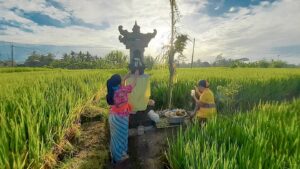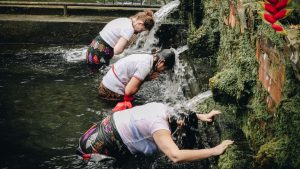Nestled in the lush highlands of central Bali, Tirta Empul Temple stands as one of the island’s most sacred and spiritually significant landmarks. Located in the village of Manukaya, Tampaksiring, this ancient Hindu water temple is famous for its holy spring water, where locals and visitors alike come to purify the body, mind, and soul through a centuries-old ritual known as melukat—a traditional Balinese purification ceremony.
Whether you are a spiritual seeker, a cultural enthusiast, or a curious traveler, a visit to Tirta Empul offers an unforgettable glimpse into Bali’s living traditions and deep spiritual heritage.
Tirta Empul Temple dates back to around 962 AD, during the reign of King Sri Chandrabhaya Warmadewa. According to Balinese mythology, the temple was built around a spring created by the god Indra to revive his poisoned troops after a battle with an evil king named Mayadanawa. The spring was believed to have miraculous healing powers, and the site soon became a sacred place of worship.
The name “Tirta Empul” literally translates to “Holy Water Spring”, a name that captures the essence of the temple’s significance.

1. Preparation
- Attire: Wear a traditional Balinese sarong and sash (kamen). These are available for rent at the temple entrance.
- Offerings: Prepare a canang sari, a small offering made of palm leaves, flowers, and incense.
- Personal Items: Bring a change of clothes, towel, and a plastic bag for wet items.
2. Making Offerings and Prayers
At the main temple area, present your canang sari and offer a prayer.
This is a moment of reflection, where you set your intentions for the ritual.
3. Entering the Purification Pools
The temple features two main pools with 30 spouts.
Start at the second spout from the left; the first is reserved for children under 10.
Proceed sequentially from one spout to the next.
At each spout, perform the following:
Kumkum (rinse your mouth) three times.
Cuci muka (wash your face) three times.
Minum (drink) the holy water three times, then spit it out.
Mandi (bathe) by pouring water over your head and body.
Berdoa (pray) for spiritual cleansing and blessings.
Skip the 11th and 12th spouts, as they are designated for rituals concerning the deceased.
4. Final Blessing
After completing the ritual, you may receive a final blessing from a temple priest, who sprinkles holy water on you and applies rice grains to your forehead as symbols of prosperity and purity.

Exploring the Temple area
Beyond the purification pools, Tirta Empul Temple boasts a large and beautifully designed complex, divided into three main sections:
- Jaba Pura (Outer Courtyard): The entrance area where visitors can observe temple life and prepare for the purification ritual.
- Jaba Tengah (Central Courtyard): The location of the main bathing pools and purification springs.
- Jeroan (Inner Courtyard): A sacred space reserved for prayer and worship, featuring altars and shrines to various Hindu deities.
Throughout the temple, visitors will see ornate stone carvings, guardian statues, and traditional Balinese architecture, offering both cultural richness and spiritual depth.
Tirta Empul isn’t just a tourist site—it remains an active place of worship. Balinese Hindus from across the island come here regularly to perform purification rituals, especially during full moons, religious festivals, or personal spiritual needs.
It’s also a deeply communal space, where offerings are made, prayers are recited, and traditional ceremonies are performed—keeping ancient practices alive in the heart of modern Bali.
To ensure a respectful and meaningful visit, keep the following tips in mind:
- Dress Modestly: Wear traditional Balinese temple attire or rent a sarong and sash at the entrance. Shoulders and knees should be covered.
- Participate Respectfully: Visitors are welcome to join the purification ritual, but do so with humility and mindfulness of its sacred meaning.
- Bring Offerings: If you wish to pray or participate in a ceremony, bring or purchase a canang sari, a small daily offering made of flowers and incense.
- e Mindful of Photography: Photos are allowed, but avoid taking pictures in sacred areas or of worshippers during prayer unless you have permission.
- Avoid the Inner Sanctum: Non-Hindus are not permitted to enter the innermost sanctuaries used for private religious rites.
- Don’t Wear Soap or Sunscreen in the Pools: To protect the purity of the spring water, avoid entering the pools with chemical substances on your skin.

Tirta Empul Temple is open daily from 8:00 AM to 5:00 PM, but the best time to visit is early in the morning, when the temple is quieter and the atmosphere more serene. You may also choose to visit during major Balinese festivals like Galungan or Kuningan to witness the temple at its most vibrant—though these days are also the busiest.
A visit to Tirta Empul Temple is more than just sightseeing—it’s a chance to connect with Bali’s deep spiritual roots, witness living religious traditions, and participate in a purification ritual that has been practiced for generations. Whether you take part in the ritual yourself or simply observe, you’ll leave with a deeper appreciation for Balinese culture, faith, and the healing power of water.
Experience the purification by staying at Puri Gangga Resort – A Home In a Living Culture. Book now!
Phone : +62 361 902222
Mobile : +62 822 9890 2222
Email : info@puriganggaresort.com
Discover More Stories



